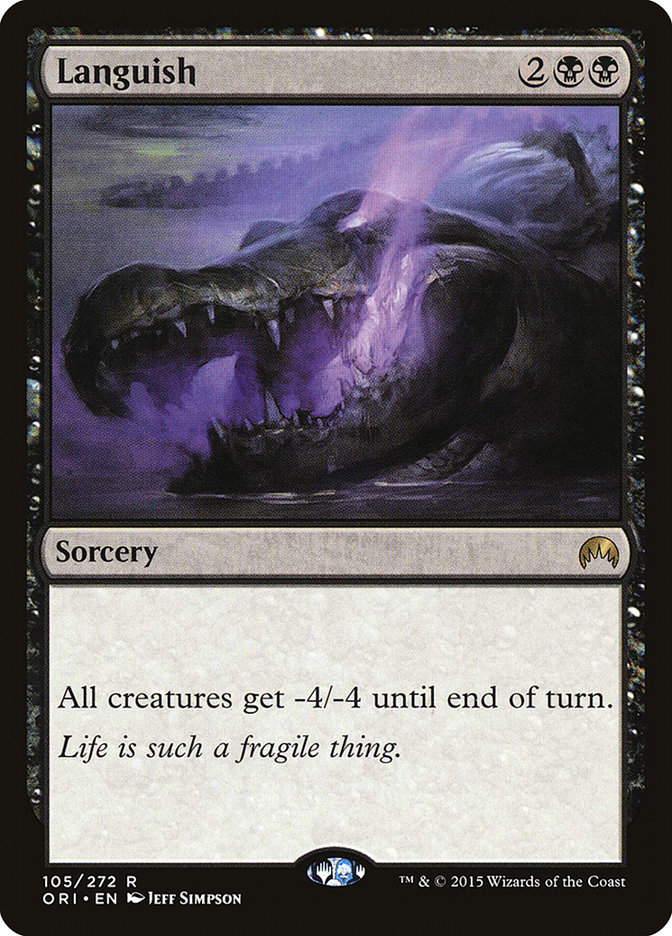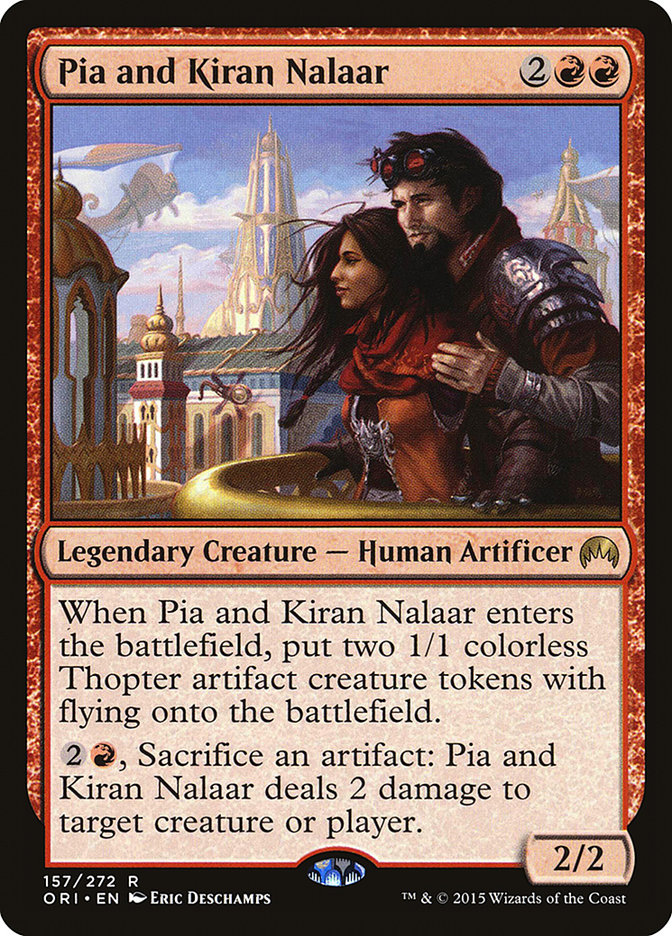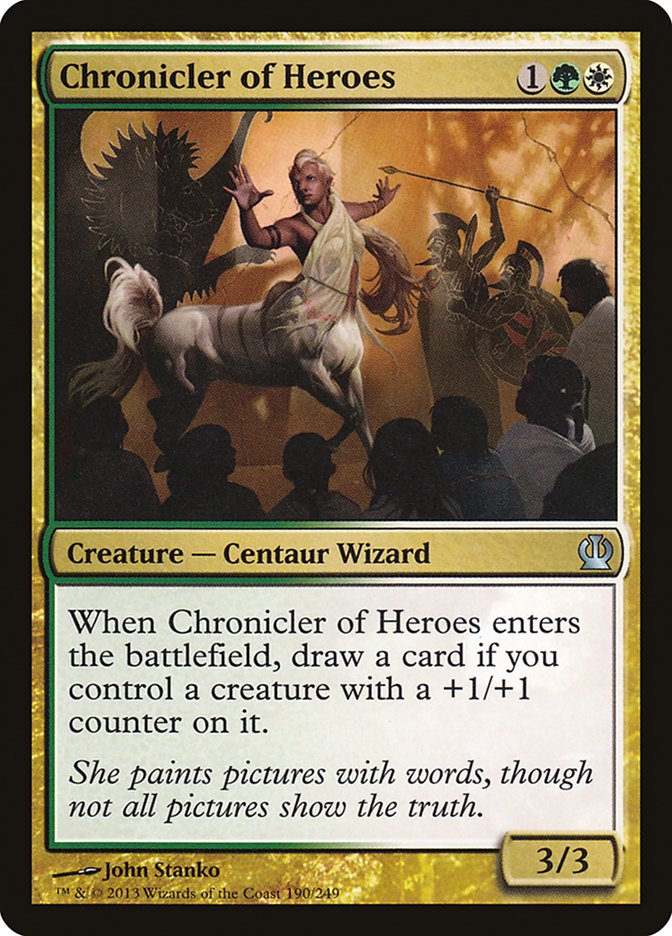Spoiler season continues, and it is chock-full of first impressions of cards I’ve never played with but which all look very sweet. Today I’m going to talk about what I think is the most interesting card of each color outside of the flip creature/planeswalker cycle.
In white, we’ve recently learned about two very impressive cards in Relic Seeker and Starfield of Nyx. Relic Seeker is a “fixed” Stoneforge Mystic, but unless there’s a really great piece of equipment in Magic Origins, I don’t know that it will have a home in Standard. That leaves the Seeker looking at Modern only, and white creatures + equipment doesn’t seem like the most impressive Modern deck at the moment. Instead, my attention is on Starfield of Nyx.
We know Constellation is a powerful mechanic. We haven’t seen them lately, but Constellation decks used to be a major force in Standard. Back to Nature kept them down, but people haven’t been playing Back to Nature lately because Constellation hasn’t really showed up in recent months, appearing to be held back in part by Dromoka’s Command. Starfield of Nyx stands to change that, and early in the new Standard season we are going to have to figure out that tension: is Starfield of Nyx real enough that they have to play Back to Nature, or is Back to Nature is real enough that they can’t play Starfield of Nyx?
The obvious direction with Starfield of Nyx is to play it in Abzan Constellation with Doomwake Giant, Courser of Kruphix, Eidolon of Blossoms, and whatever other enchantments you want to play. This is likely the best home for Starfield of Nyx, as it’s a deck with a proven history of success that gains a powerful new tool. The biggest concern aside from Back to Nature is that this new tool might not be what the deck needed. It’s slow, in that it’s expensive and requires a lot of setup, and without a huge board in play already or some strong Constellation triggers it doesn’t do anything the turn it comes into play. Abzan Constellation already has a great late-game, so maybe this isn’t adding that much. I’d actually be surprised if the deck that this inspired in that direction actually ended up wanting to play four copies of this.
Another option, what about White Devotion?
Creatures (18)
- 4 Soldier of the Pantheon
- 3 Brimaz, King of Oreskos
- 4 Eidolon of Countless Battles
- 3 Anafenza, Kin-Tree Spirit
- 4 Kytheon, Hero of Akros
Lands (24)
Spells (18)
Sideboard

This deck has a mix of enchantment threats that are likely to find themselves in the graveyard, like Eidolon of Countless Battles and Lightform, and enchantments that stay on the battlefield and would benefit from being able to attack thanks to Starfield of Nyx, like Banishing Light and Citadel Siege.
Overall, I feel like the individual power level of the cards is alright, not amazing, but solid, and the synergy is similar – present, but not overwhelming. The biggest strength is getting to play 21 basic lands, but something about this deck just doesn’t feel quite there.
On the other hand, and despite the fact that I said I was most drawn to Starfield of Nyx, writing out all those legendary white creatures in a decklist reminded me that there is an equipment that’s potentially worth finding in Standard – Hero’s Blade. Now I want to quickly look at Relic Seeker in a bonus decklist:
4 Kytheon, Hero of Akros
3 Soldier of the Pantheon
4 Zurgo Bellstriker
1 Soulfire Grand Master
3 Anafenza, Kin-Tree Spirit
4 Relic Seeker
4 Hero’s Blade
1 Alesha, Who Smiles at Death
1 Anax and Cymede
3 Brimaz, King of Oreskos
1 Pia and Kiran Nalaar
3 Wild Slash
3 Lightning Strike
3 Gods Willing
4 Battlefield Forge
4 Temple of Triumph
1 Mana Confluence
5 Mountain
8 Plains
Sideboard:
3 Valorous Stance
2 Mastery of the Unseen
2 Rending Volley
1 Barrage of Boulders
3 Glare of Heresy
2 Surge of Righteousness
2 Goblin Heelcutter
I know a lot of decks play only three Zurgo, but I think the interaction between Dash and both Hero’s Blade and Kytheon, Hero of Akros are too good not to maximize. The mix of legends is a little arbitrary, but I’m trying to skew toward power while diversifying enough that I won’t have too much trouble getting three creatures in play for Kytheon. It’s possible that I should have slightly fewer redundant copies and more non-legendary creatures, since I don’t need to draw very many legendary creatures per game to make Hero’s Blade good. On the other hand, if I don’t draw any, it’s terrible. I think this is close to the right mix, but I have no reason to think it’s exact.
I like that I feel like I’m not giving up very much raw power level to play this many legendary creatures, but people who are more drawn to Goblin Rabblemaster and Stoke the Flames than I am might argue otherwise.
In blue, I have to wonder about Sphinx’s Tutelage and Jhessian Thief, and I suspect the most-played blue card we know about so far will likely be Clash of Wills, as unexciting as it is. By far the most interesting card, and the card met with the most anticipation, is Day’s Undoing.
The first direction people are looking to go with this is casting it at instant speed to get around the drawback. One thing I like about this is that it means Day’s Undoing ends up in your graveyard, and I always love being able to cycle through my deck infinitely. On the other hand, I think it’s not worth the setup cost. It almost makes me wonder if anyone else misread the card the way that I did at first, and failed to process the “if it’s your turn clause,” because if we could be building a three mana Time Stop + Timetwister, then we’d have something worth doing. My next thought was to try to use this as a Sundial of the Infinite to get around “at end of turn” triggers, but then I realized that that card works by ending the turn while those things are on the stack – if you end the turn at sorcery speed, most of those cards, like Whip of Erebos, say, “at the beginning of the next end of turn step” and they’ll just trigger on your opponent’s turn instead.
As-is, I think the best way to use Day’s Undoing is just to play a lot of instants. After all, if you and your opponent each have a deck full of instants and some mana untapped when Day’s Undoing resolves, the “End the Turn” clause likely benefits you because your opponent can’t use their untapped lands to cast the new spells they drew but you can still use your untapped lands on their turn for your instants.
We haven’t had a lot of good Timetwisters lately, so I think a lot of players don’t really know how to build decks with them. The best are combo decks that can expect to win a reasonable portion of the time that they use one card to draw seven, but Standard doesn’t really have a lot of support for that, and the “end the turn” clause intentionally gets in the way of that. Beyond that, the easiest way to break the symmetry is to play cheaper cards than your opponent such that you can expect to have a smaller hand when you cast it, and you can expect to profitably use the new cards faster than your opponent. Other options tend to overlap, but include things like “develop much more mana than your opponent” or “establish some kind of lock so you can ignore most of the cards your opponent has drawn.”
In Standard right now, I think the best way to use Day’s Undoing is in U/G so that you can play mana creatures and dump your hand onto the table, and the best card to use with Day’s Undoing is Prophet of Kruphix, which really minimizes the drawback and maximizes the payoff. Once you’re playing Prophet of Kruphix, Yisan, the Wanderer Bard becomes very tempting:
Creatures (33)
- 4 Elvish Mystic
- 2 Polukranos, World Eater
- 3 Prophet of Kruphix
- 4 Kiora's Follower
- 3 Courser of Kruphix
- 2 Genesis Hydra
- 4 Yisan, the Wanderer Bard
- 2 Whisperwood Elemental
- 1 Profaner of the Dead
- 1 Sidisi's Faithful
- 2 Nissa, Vastwood Seer
- 1 Bounding Krasis
- 4 Honored Hierarch
Lands (23)
Spells (4)

I have concerns about this build of this deck’s ultimate finishing power – it can empty its hand and cast Day’s Undoing fairly quickly, but it looks vulnerable to flooding out by drawing too many late Honored Hierarchs. This is why I erred toward putting a lot of finishers in the sideboard. I’m not sure that Honored Hierarch is better than Sylvan Caryatid in this deck, but I’d certainly want to give it a chance. I also really like the idea of using Yisan at the end of my opponent’s turn to find Profaner of the Dead and then untapping and casting Day’s Undoing. I also really like the idea of untapping Yisan with Bounding Krasis to immediately get a four.
Languish is the best black card so far by a wide margin. Languish is an interesting midpoint between Drown in Sorrow and Crux of Fate. -4/-4 is enough to kill every creature in a large number of decks, but there are a lot of creatures it doesn’t kill. Luckily, many of the best creatures that live through it at the moment are also black – Siege Rhino, Tasigur, the Golden Fang, Doomwake Giant, Silumgar, the Drifting Death or Dragonlord Silumgar, and Sidisi, Undead Vizier. It’s sweet that you can build around this to create one-sided Wraths, but realistically this is still just going to function as a black sweeper that will most often be played in any black control deck.
One problem is that, at least while Deathmist Raptor, Den Protector, Whisperwood Elemental and Collected Company are big in the format, sorcery speed sweepers aren’t what they once used to be – and a resurgence of Eidolon of Blossom decks with Starield of Nyx certainly wouldn’t help. As a result, I think we’ll rarely see this as a card people play four copies of and most control decks will just play one or two.
Of course, you could really push it:
Creatures (23)
- 4 Satyr Wayfinder
- 4 Siege Rhino
- 1 Gurmag Angler
- 2 Tasigur, the Golden Fang
- 2 Sidisi, Undead Vizier
- 4 Den Protector
- 4 Deathmist Raptor
- 2 Nissa, Vastwood Seer
Planeswalkers (2)
Lands (24)
Spells (11)

One advantage of Languish over the other sweepers in Standard is that it answers a monstrous Fleecemane Lion, which most of the rest of the “answer” spells generally can’t, and that this moves our Abzan deck away from playing any Fleecemane Lions of its own. Instead, this deck is looking to maximize its Languishes by playing nine creatures that live though it with a few planeswalkers and Deathmist Raptors, which often don’t mind going to the graveyard. Between Languish, Siege Rhino, and Feed the Clan I expect this deck to be well-positioned against Atarka Red. The sideboard gives me a lot of discard along with Read the Bones and planeswalkers to replace my removal spells against control. I expect that this deck is poorly positioned against other Abzan Control decks, where Languish will not be very good, but it should be good against Abzan Aggro decks.
Red isn’t off to a great start so far. Fiery Impulse will replace Wild Slash or Magma Spray in some decks, and Avaricious Dragon might be a reasonable top-end spell in a very fast red deck, likely in small numbers and or even just out of the sideboard. Even then, it’s probably not offering enough payoff to play it over Thunderbreak Regent. The card I like most so far isn’t even that good, but I have a great love of Siege-Gang Commander and Marsh Flitter, so Pia and Kiran Nalaar makes me pretty happy.
I figure I’ll take advantage of this to see what kind of progress we’re making on getting a playable U/R Artifact deck together:
Creatures (22)
- 4 Ornithopter
- 4 Phyrexian Revoker
- 4 Chief Engineer
- 3 Renowned Weaponsmith
- 4 Hewed Stone Retainers
- 3 Pia and Kiran Nalaar
Lands (21)
Spells (17)

Probably still not there, but it’s getting closer. Hewed Stone Retainers are probably a lot better than Illusory Angel. Despite giving up flying – which is huge – you can use your blue creatures to cast them, which makes them much easier to play as a second spell, plus it’s also cheap for them to pick up a Ghostfire Blade. I think Bident of Thassa is one of the best payoff cards for the creatures that give you mana for artifacts, but it’s hard to find other cards to make it good since you really don’t want to have to fill your deck with small fliers. Enter Pia and Kiran Nalaar where they can really shine – they’re great with other artifacts, but especially so with Bident of Thassa.
Finally, in green, Elemental Bond is a card that deserves serious attention. Three is a very reasonable amount of mana for an engine like this, and three power is pretty easy to come by. The most important part is that this works with Deathmist Raptor:
Creatures (29)
- 4 Elvish Mystic
- 4 Fleecemane Lion
- 1 Boon Satyr
- 4 Chronicler of Heroes
- 4 Den Protector
- 4 Deathmist Raptor
- 4 Avatar of the Resolute
- 4 Honored Hierarch
Lands (22)
Spells (9)

This deck is doing some unusual things, like playing Chronicler of Heroes. I think Honored Hierarch makes Avatar of the Resolute a lot better, and with 23 cards that can make +1/+1 counters, I figure Chronicler of Heroes will often be turned on. Even when it isn’t, I’ll still get a card off Elemental Bond.
I’m also only playing seventeen creatures that trigger Elemental Bond, and I don’t know if that’s enough. I have Collected Company to find more, and I can return Deathmist Raptor for more, but it’s possible that the deck might need more than that to really work. If I find that Elemental Bond isn’t doing enough, I’d try to move Boon Satyr to the maindeck. It’s tricky, because I think the one-drops are really important and I think you need Den Protector to support Deathmist Raptor, and from there every other creature already has three power. I think this means I’d have to just cut another Elemental Bond for a Boon Satyr. I started with four Elemental Bonds and no Boon Satyrs, but swapped out one for the first Boon Satyr to help out my hits for the other Bonds and my Companies.
Another choice that I think I like here, and that I think people might begin to do more often after playing with the card, is having Kytheon, Hero of Akros in the sideboard. This seems strange for such a generally powerful card, but one-mana 2/1s just aren’t very good in this format. You will need to only be playing it when you can expect to get more than that out of the front side of the card, and I think there are some matchups where it will be great to have Gideon and relatively easy to flip it, like against slower control decks that are leaning too heavily on sweepers. But against other creature decks, they’ll just block it when you attack and there really aren’t very many ways to clear their blockers.
Overall, I think I like the direction this set is going. I think I like how renown is being used so far – to balance mana creatures by making them wait a turn to make mana, or making you work to get an effect that’s like an “enters the battlefield” ability, such as we see on Relic Seeker. The creatures still offer high potential, but the delay requirement makes it so that it’s more interactive. I actually really like Relic Seeker in that way, compared to Stoneforge Mystic: where before you’re basically guaranteed a two-for-one, this time around your opponent can actually try to stop you. Compared to a Scroll Thief-type effect that can run away with the game if the opponent stumbles, because Renown only triggers the once this has a set cap on how punishing it can be. You play the card, and it gives you a simple quest. You complete the quest and you feel good, and then you don’t have to worry about the card anymore. This seems fun and elegant.
I’m still waiting for them to demonstrate why Spell Mastery is an interesting mechanic, but I wouldn’t be surprised if they can do so. I’ll have to keep following the spoilers and wait and see.






